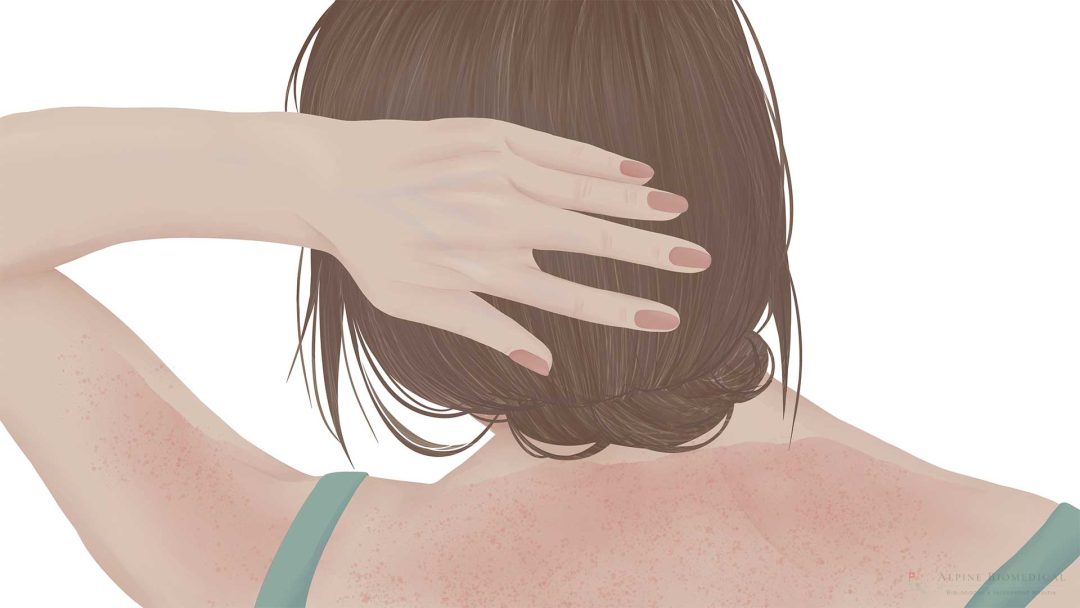Sun Allergy

A sun allergy is a condition in which exposure to sunlight can cause unpleasant skin reactions. From polymorphic light dermatosis to light urticaria – there are different types of sun allergies that can have different symptoms and triggers. This article aims to give you an overview of the different types of sun allergies, their symptoms, treatment options and prevention tips.
What is a Sun Allergy?
A sun allergy, also known as light urticaria, is a hypersensitivity reaction of the skin to sunlight. In general, the skin’s protection against UV light fails and inflammation is caused in affected areas. This causes cells to release histamine, which triggers the typical symptoms such as redness and burning. Reactions typically occur after sun exposure and can vary from person to person.
Types of Sun Allergy
There are several types of sun allergy, each characterised by different symptoms and triggers. The types include polymorphous light dermatosis, Majorca acne, photoallergic reaction, phototoxic reaction and light urticaria.
Each of these forms has specific characteristics and triggers that require differentiated treatment and should definitely be discussed with a doctor to protect you from injury.
Polymorphic Light Dermatosis
Polymorphic light dermatosis is the most common form of sun allergy and manifests itself as an itchy rash, red spots or blisters. The cause is increased exposure to UV radiation.
Majorca Acne
Majorca acne mainly occurs with excessive use of oily sun creams, as this clogs the sebaceous glands. In combination with a sensitive reaction of the skin to sunlight, this leads to inflammation of the sebaceous follicles and the development of Majorca acne.
Photoallergic Reaction
In a photoallergic reaction, the body reacts primarily to the ingredients in sunscreens, such as fragrances or benzophenone. This reaction of the immune system often only occurs hours after exposure to the sun and can also classically lead to redness, itching and burning of the skin.
Phototoxic Reaction
The phototoxic reaction of the skin is similar to the photoallergic reaction. However, it is often caused by other chemical substances (such as drugs or plants) that cause an increased reaction to sunlight. It is typically characterised by the appearance of burns in areas that have also been treated with sun cream.
Light Urticaria
Light urticaria is a special form of hives. It is an immediate reaction of the body to the sun’s rays, in which wheals form and severe reddening occurs. The body releases more histamine and causes an immunological reaction.
Localisation of Sun Allergy
Sun allergy can affect various areas of the skin. Areas of the skin that are more frequently exposed to the sun and more sensitive to the sun are particularly susceptible. These include in particular
- Face and ears
- Hands and arms
- Décolleté or back
In these areas in particular, you should make sure you use the correct, harmless sun protection to prevent skin damage or alleviate the symptoms.
Causes of Sun Allergy
The causes of sun allergies can be varied and range from genetic predispositions to environmental factors such as medication or histamine intolerance. A better understanding of the causes can help you to take preventative measures.
In the case of sun allergies, the skin reacts to UV radiation from the sun and causes an immunological reaction. This excessive immunological reaction is due to an imbalance in the immune system.
The possible causes of the immunological imbalance in sun allergies are listed below:
Sensitive, Pre-damaged Skin
People with particularly sensitive skin or a history of skin diseases such as eczema or dermatitis may be more susceptible to sun allergies.
Chemical Reactions
Some chemical substances contained in sunscreens, cosmetics or skin care products can trigger allergic reactions to sunlight and cause a phototoxic or photoallergic reaction.
Genetic Predisposition
Genetic predisposition can increase the risk of sun allergies, as certain genes can influence the skin’s reaction to UV radiation and thus trigger an increased reaction.
Medication
Some medications, including antibiotics, antidepressants, anti-inflammatory drugs and diuretics, can trigger phototoxic reactions and increase the risk of sun allergies.
Drug-Induced Photosensitivity – a Continuing Diagnostic Challenge
Drug‐induced photosensitivity: culprit drugs, potential mechanisms and clinical consequences
Drug-induced cutaneous photosensitivity: incidence, mechanism, prevention and management
Histamine intolerance
Individuals with histamine intolerance may be more susceptible to allergic reactions to sunlight because histamine plays a role in regulating the immune response.
Oxidative Stress
Oxidative stress, caused by an excess of free radicals in the body, leads to increased skin sensitivity to UV radiation and increases the risk of sun allergies.
HPU
Intestinal Dysbiosis
An imbalance in the intestinal flora can weaken the immune system and make the skin more sensitive to UV radiation. This in turn increases the risk of sun allergies.
Symptoms of Sun Allergy
Typical symptoms of sun allergy are often varied and can occur individually or in combination:
- Itchy rash
- Reddening of the skin
- Formation of blisters or papules
- Burning and pain on the skin
- Dry or irritated skin
Sun Allergy, What To Do?
The treatment of sun allergy can involve various approaches.
A precise diagnosis should always be carried out before treatment in order to determine the individual causes.
Symptomatic treatment approaches include the use of topical corticosteroids, antihistamines in the form of tablets or liquids and generally moisturising creams.
Corticosteroids, especially when applied topically, help against itching and inflammation by blocking the inflammatory reaction in the skin.
Antihistamines have a similar mode of action, as they block the histamine in the body, which is primarily responsible for the allergic reaction, and thus prevent the typical inflammatory reactions.
In addition, moisturising creams can help to strengthen the skin’s natural barrier, relieve dryness and reduce symptoms. It is essential to ensure that such creams are of high quality,
Holistic, complementary medical approaches can also be used to treat sun allergies. These should always keep the individual causes of the sun allergy in mind. Holistic therapies include, for example, intestinal cleansing, cleansing the blood of harmful immune complexes with INUSpheresis, intravenous laser therapy, infusion therapy and orthomolecular medicine.
Home Remedies for Sun Allergy
Home remedies for sun allergy, such as the use of aloe vera, camomile and lavender, offer an uncomplicated remedy that you can also use at home. They have anti-inflammatory, soothing and cooling properties that can help to regenerate the skin and reduce swelling.
Aloe Vera
Aloe vera contains various compounds, such as glycoproteins, which help to soothe redness and itching. Especially when cooled, aloe vera can combat symptoms such as burning and heat that typically occur with sun allergies.
Efficacy of aloe vera cream in prevention and treatment of sunburn and suntan
The Effect of Aloe Vera Clinical Trials on Prevention and Healing of Skin Wound: A Systematic Review
Curd and Yoghurt
Quark and yoghurt can be applied locally to sensitive skin. The ingredients they contain have a soothing effect and can reduce inflammation.
Lavender
Lavender is often known as a soothing scent. Lavender in oil form can not only have a calming effect on sun allergies, but can also have an antimicrobial effect. These properties are attributed to the active ingredients linalool and linalyl acetate. Lavender oil can provide quick relief from itching. It should not be applied pure to the skin, but diluted with a base oil.
Effect of Lavender (Lavandula angustifolia) Essential Oil on Acute Inflammatory Response
How can Sun Allergy be Prevented?
Preventive measures such as wearing sun-protective clothing, applying sun cream with a high sun protection factor and avoiding excessive sun exposure can help to reduce the risk of sun allergy. When choosing a sun cream, care should be taken to ensure that it is well tolerated and contains natural ingredients.
It is also beneficial to gradually acclimatise the skin to the sun. During the winter months, the skin loses its ability to protect itself against UV radiation. A slow approach, with short periods of sunbathing, is recommended.
Sun Cream for Sun Allergy
It is important to choose a suitable sun cream that is kind to the skin and does not cause skin irritation. Sun creams with zinc oxide can be a gentle option. Moreover, you should pay particular attention to the ingredients of sun creams, as chemical filters and fragrances in particular can cause irritation. It should also be noted that the ingredients are absorbed into the body via the skin (transdermally) and always have a systemic effect on health.
Allergy to Sun Cream
An allergy to sun cream is due to the ingredients of the sunscreen. The most common symptoms include skin rashes, redness, itching and swelling that can occur after applying sun cream. These allergic reactions can increase skin sensitivity to sunlight and lead to further discomfort. That’s why you should always look for high-quality ingredients when buying sun cream.
Med. pract. Dana Hreus M.A.
Sun allergy is an immune disorder with a variety of causes. These causative factors should be identified before treatment so that long-term improvement can be achieved.

Frequently asked questions and answers on the subject of sun allergy.
Sun allergy can spoil the enjoyment of the sun for those affected and lead to unpleasant symptoms. Below we answer some frequently asked questions about sun allergies.
The treatment of a sun allergy rash can vary depending on the severity of the symptoms. Cooling compresses, low-irritant skin care products and, if necessary, creams containing cortisone can have a soothing effect. Cooling aloe vera can be applied to reddened and burning areas. However, if more severe or persistent symptoms occur, it is advisable to consult a dermatologist.
The terms sun allergy and light allergy are often used interchangeably, but refer to different types of skin reactions. Sun allergy refers to a hypersensitivity reaction of the skin to sunlight. Light allergy describes an allergic reaction to certain light sources that do not necessarily come from sunlight.
There is limited scientific evidence that calcium is effective in preventing or treating sun allergies. Some studies suggest that adequate calcium intake may reduce skin sensitivity, but further research is needed to confirm the efficacy and safety of calcium supplements in the treatment of sun allergies.
Further information
The information listed contains relevant topics and serves to improve understanding.